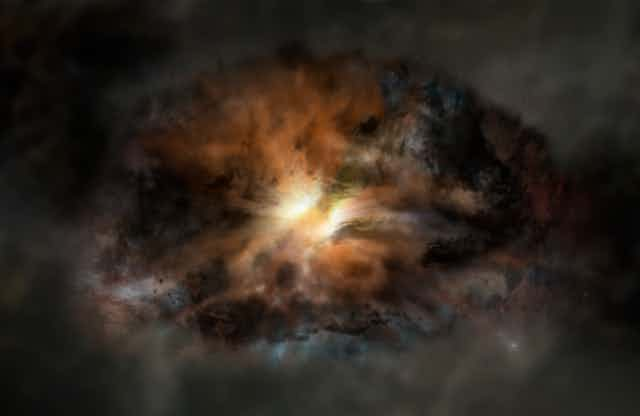Active galaxies are some of the most luminous and impressive objects in the sky. They tend to be massive, distant and emit extraordinary amounts of energy as material falls into the supermassive black hole that lurks at their centre. Astronomers have recently discovered that some of them are also hidden from plain view by huge amounts of gas and smoke-like dust. But it is unclear how these rare objects form and feed.
Now our team of astronomers has worked out more about the origin of the most luminous galaxy found in the universe: a “quasar” called W2246. Our findings, published in Science, show clear signs of W2246 forming by several galaxies merging.
W2246 was first discovered in the all-sky infrared survey made by the WISE spacecraft in 2010. But we don’t see it as it looks today. When we look out into the universe we detect light that has taken some appreciable time to get to us. This galaxy is so far away that we see it as it was when the universe was only about 8% of its present age.
The object is extremely bright – about 10,000 times more luminous than our galaxy, the Milky Way. Previous work using a range of cutting-edge telescopes – including the Atacama Large Millimetre Array (ALMA), and the Hubble and Herschel Space Telescopes – confirmed in 2016 that W2246 is the current holder of the record for the most luminous galaxy in the universe.
The bulk of the power from W2246 emanates from a relatively compact region in its centre, several times smaller than the Milky Way. The images also show that this region contains a remarkable cloud of hot, uniform, high-pressure gas, plausibly starting to expand out as a bubble in all directions.
New observations
The latest observations were carried out by my colleague Tanio Diaz Santos in Chile, and 11 other astronomers, using the ALMA and Jansky Very Large Array (JCLA) telescopes, at excellent sites in Chile and New Mexico respectively. The work has revealed the smog of gas and dust contained within W2246 in unprecedented detail.

The fact that W2246 could be so bright without feeding on nearby galaxies has long been a mystery to astronomers – potentially challenging our theories about galaxy formation. But our new results reveal that there are indeed a number of nearby companion galaxies that are in the process of being gobbled up by this object. This is evidenced by connecting dust bridges of carbon-rich solid material, similar to diesel soot. These trace the routes along which matter from the companion galaxies is being sucked in towards the supermassive black hole.
The presence of dust is important as it is made of elements that are only produced by nuclear reactions deep inside massive stars, and are then spread around the galaxy when these stars explode as supernovae. This indicates that the gas seen around W2246 has been cycled inside stars in the past – probably in the surrounding galaxies – prior to the start of the galaxy’s current dramatic burst of activity. The new images therefore provide insight not only into the activity in the galaxy as we see it today, but also into its history at even earlier times.
To be visible to ALMA, the bridging dust must be actively heated. This could be done by young stars that also occupy the bridges, or by the radiation from the hugely bright core of W2246. The conditions in the gas within the bridges suggest that even if W2246 is the primary heat source, the gas in the bridges can still collapse under its own gravity to form new stars in dense clouds, which would allow it to be gobbled up by the central black hole to fuel W2246.
From the relative speed and separation of the companion galaxies, it is possible to work out how much mass they contain. We can also estimated that the duration of the current interaction is about 200m years. Together, we used this to determine the rate at which gas must be fed into the black hole, uncovering that it is indeed sufficient to produce the dramatic energy output we see from the object.

However, the details of what happens within the bright compact core of the galaxy as this material rains in, and enters the the black hole (that then heats and drives away material) can’t be seen. Observations on finer scales will be needed to investigate what happens deep in the heart of W2246.
Out with a whimper?
Luckily, further observations using ALMA and the forthcoming James Webb Space Telescope (JWST), scheduled for launch in 2021, will be able to reveal exactly how the gas and dust travels within and is distributed around the galaxies, gets converted into stars and is consumed by the black hole.
Not only will these observations give insight into this most extreme galaxy, it could also help us understand the processes that build more ordinary galaxies, and the conditions required to ignite all galaxies’ most luminous phases.
It’s been great watching W2246. In about 100m years, it will definitely have finished its meal of neighbouring galaxies. It will then lose its sparkle, and another object will take the crown of being the brightest galaxy in the universe. Nothing is forever.

